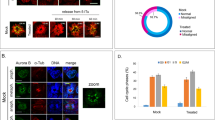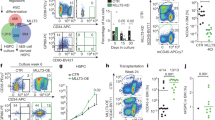Abstract
Activating mutations in the tyrosine kinase Janus kinase 2 (JAK2) cause myeloproliferative neoplasms, clonal blood stem cell disorders with a propensity for leukaemic transformation. Leukaemia inhibitory factor (LIF) signalling through the JAK-signal transducer and activator of transcription (STAT) pathway enables self-renewal of embryonic stem (ES) cells. Here we show that mouse ES cells carrying the human JAK2V617F mutation were able to self-renew in chemically defined conditions without cytokines or small-molecule inhibitors, independently of JAK signalling through the STAT3 or phosphatidylinositol-3-OH kinase pathways. Phosphorylation of histone H3 tyrosine 41 (H3Y41) by JAK2 was recently shown to interfere with binding of heterochromatin protein 1α (HP1α). Levels of chromatin-bound HP1α were lower in JAK2V617F ES cells but increased following inhibition of JAK2, coincident with a global reduction in histone H3Y41 phosphorylation. JAK2 inhibition reduced levels of the pluripotency regulator Nanog, with a reduction in H3Y41 phosphorylation and concomitant increase in HP1α levels at the Nanog promoter. Furthermore, Nanog was required for factor independence of JAK2V617F ES cells. Taken together, these results uncover a previously unrecognized role for direct signalling to chromatin by JAK2 as an important mediator of ES cell self-renewal.
This is a preview of subscription content, access via your institution
Access options
Subscribe to this journal
Receive 12 print issues and online access
$209.00 per year
only $17.42 per issue
Buy this article
- Purchase on Springer Link
- Instant access to full article PDF
Prices may be subject to local taxes which are calculated during checkout






Similar content being viewed by others
Accession codes
References
Campbell, P. J. & Green, A. R. The myeloproliferative disorders. N. Engl. J. Med. 355, 2452–2466 (2006).
Levine, R. L. & Gilliland, D. G. Myeloproliferative disorders. Blood 112, 2190–2198 (2008).
James, C. et al. A unique clonal JAK2 mutation leading to constitutive signalling causes polycythaemia vera. Nature 434, 1144–1148 (2005).
Levine, R. L. Activating mutation in the tyrosine kinase JAK2 in polycythemia vera, essential thrombocythemia, and myeloid metaplasia with myelofibrosis. Cancer Cell 7, 387–397 (2005).
Baxter, E. J. Acquired mutation of the tyrosine kinase JAK2 in human myeloproliferative disorders. Lancet 365, 1054–1061 (2005).
Kralovics, R. A gain-of-function mutation of JAK2 in myeloproliferative disorders. N. Engl. J. Med. 352, 1779–1790 (2005).
Moreau, J. Leukaemia inhibitory factor is identical to the myeloid growth factor human interleukin for DA cells. Nature 336, 690–692 (1988).
Smith, A. G. Inhibition of pluripotential embryonic stem cell differentiation by purified polypeptides. Nature 336, 688–690 (1988).
Williams, R. L. Myeloid leukaemia inhibitory factor maintains the developmental potential of embryonic stem cells. Nature 336, 684–687 (1988).
Niwa, H., Burdon, T., Chambers, I. & Smith, A. Self-renewal of pluripotent embryonic stem cells is mediated via activation of STAT3. Genes Dev. 12, 2048–2060 (1998).
Raz, R., Lee, C., Cannizzaro, L. A., d'Eustachio, P. & Levy, D. E. Essential role of STAT3 for embryonic stem cell pluripotency. Proc. Natl Acad. Sci. USA 96, 2846–2851 (1999).
Ying, Q. L., Nichols, J., Chambers, I. & Smith, A. BMP induction of Id proteins suppresses differentiation and sustains embryonic stem cell self-renewal in collaboration with STAT3. Cell 115, 281–92 (2003).
Ying, Q. The ground state of embryonic stem cell self-renewal. Nature 453, 519–523 (2008).
Dawson, M. A. JAK2 phosphorylates histone H3Y41 and excludes HP1alpha from chromatin. Nature 461, 819–822 (2009).
Li, J. JAK2 V617F impairs hematopoietic stem cell function in a conditional knock-in mouse model of JAK2 V617F-positive essential thrombocythemia. Blood 116, 1528–1538 (2010).
Prchal, J. F. & Axelrad, A. A. Bone-marrow responses in polycythemia vera. N. Engl. J. Med. 290, 1382 (1974).
Ohashi, T., Masuda, M. & Ruscetti, S. K. Induction of sequence-specific DNA-binding factors by erythropoietin and the spleen focus-forming virus. Blood 85, 1454–1462 (1995).
Schneider, H., Cohen-Dayag, A. & Pecht, I. Tyrosine phosphorylation of phospholipase C gamma 1 couples the Fc epsilon receptor mediated signal to mast cells secretion. Int. Immunol. 4, 447–453 (1992).
Thompson, J. E. Photochemical preparation of a pyridone containing tetracycle: a Jak protein kinase inhibitor. Bioorg. Med. Chem. Lett. 12, 1219–1223 (2002).
Pardanani, A. TG101209, a small molecule JAK2-selective kinase inhibitor potently inhibits myeloproliferative disorder-associated JAK2V617F and MPLW515L/K mutations. Leukemia 21, 1658–1668 (2007).
Ihle, J. N. STATs: Signal Transducers and Activators of Transcription. Cell 84, 331–334 (1996).
Niwa, H., Ogawa, K., Shimosato, D. & Adachi, K. A parallel circuit of LIF signalling pathways maintains pluripotency of mouse ES cells. Nature 460, 118–122 (2009).
Matsuda, T. STAT3 activation is sufficient to maintain an undifferentiated state of mouse embryonic stem cells. EMBO J. 18, 4261–4269 (1999).
Grebien, F. Stat5 activation enables erythropoiesis in the absence of EpoR and Jak2. Blood 111, 4511–4522 (2008).
Wood, A. D. Id1 promotes expansion and survival of primary erythroid cells and is a target of JAK2V617F-STAT5 signalling. Blood 114, 1820–1830 (2009).
Paling, N. R.D., Wheadon, H., Bone, H. K. & Welham, M. J. Regulation of embryonic stem cell self-renewal by phosphoinositide 3-kinase-dependent signaling. J. Biol. Chem. 279, 48063–48070 (2004).
Stavridis, M. P., Lunn, J. S., Collins, B. J. & Storey, K. G. A discrete period of FGF-induced Erk1/2 signalling is required for vertebrate neural specification. Development 134, 2889–2894 (2007).
Kunath, T. FGF stimulation of the Erk1/2 signalling cascade triggers transition of pluripotent embryonic stem cells from self-renewal to lineage commitment. Development 134, 2895–2902 (2007).
Lu, C. Ras-MAPK signaling promotes trophectoderm formation from embryonic stem cells and mouse embryos. Nat. Genet 40, 921–926 (2008).
Burdon, T., Stracey, C., Chambers, I., Nichols, J. & Smith, A. Suppression of SHP-2 and ERK signalling promotes self-renewal of mouse embryonic stem cells. Dev. Biol. 210, 30–43 (1999).
Shi, S. JAK signaling globally counteracts heterochromatic gene silencing. Nat. Genet 38, 1071–1076 (2006).
Shi, S. Drosophila STAT is required for directly maintaining HP1 localization and heterochromatin stability. Nat. Cell Biol. 10, 489–496 (2008).
Chambers, I. Functional expression cloning of Nanog, a pluripotency sustaining factor in embryonic stem cells. Cell 113, 643–655 (2003).
Ivanova, N. Dissecting self-renewal in stem cells with RNA interference. Nature 442, 533–538 (2006).
Nielsen, S. J. Rb targets histone H3 methylation and HP1 to promoters. Nature 412, 561–565 (2001).
Papanayotou, C. A mechanism regulating the onset of Sox2 expression in the embryonic neural plate. PLoS Biol. 6, e2 (2008).
Neubauer, H. Jak2 deficiency defines an essential developmental checkpoint in definitive hematopoiesis. Cell 93, 397–409 (1998).
Rodig, S. J. Disruption of the Jak1 gene demonstrates obligatory and nonredundant roles of the Jaks in cytokine-induced biologic responses. Cell 93, 373–383 (1998).
Parganas, E. Jak2 is essential for signaling through a variety of cytokine receptors. Cell 93, 385–395 (1998).
Ernst, M., Oates, A. & Dunn, A. R. gp130-mediated signal transduction in embryonic stem cells involves activation of Jak and Ras/mitogen-activated protein kinase pathways. J. Biol. Chem. 271, 30136–30143 (1996).
Yuan, P. Eset partners with Oct4 to restrict extraembryonic trophoblast lineage potential in embryonic stem cells. Genes Dev. 23, 2507–2520 (2009).
Bilodeau, S., Kagey, M. H., Frampton, G. M., Rahl, P. B. & Young, R. A. SetDB1 contributes to repression of genes encoding developmental regulators and maintenance of ES cell state. Genes Dev. 23, 2484–2489 (2009).
Meissner, A. Genome-scale DNA methylation maps of pluripotent and differentiated cells. Nature 454, 766–770 (2008).
Mikkelsen, T. S. Genome-wide maps of chromatin state in pluripotent and lineage-committed cells. Nature 448, 553–560 (2007).
Hodge, D. R., Hurt, E. M. & Farrar, W. L. The role of IL-6 and STAT3 in inflammation and cancer. Eur. J. Cancer 41, 2502–2512 (2005).
Tchirkov, A. Interleukin-6 gene amplification and shortened survival in glioblastoma patients. Br. J. Cancer 96, 474–476 (2007).
Rebouissou, S. Frequent in-frame somatic deletions activate gp130 in inflammatory hepatocellular tumours. Nature 457, 200–204 (2009).
Ying, Q. & Smith, A. G. Defined conditions for neural commitment and differentiation. Meth. Enzymol. 365, 327–341 (2003).
Brewer, G. J., Torricelli, J. R., Evege, E. K. & Price, P. J. Optimized survival of hippocampal neurons in B27-supplemented Neurobasal, a new serum-free medium combination. J. Neurosci. Res. 35, 567–576 (1993).
Liu, P., Jenkins, N. A. & Copeland, N. G. A highly efficient recombineering-based method for generating conditional knockout mutations. Genome Res. 13, 476–484 (2003).
Subramanian, A. Gene set enrichment analysis: a knowledge-based approach for interpreting genome-wide expression profiles. Proc. Natl. Acad. Sci. USA 102, 15545–15550 (2005).
Ying, Q., Stavridis, M., Griffiths, D., Li, M. & Smith, A. Conversion of embryonic stem cells into neuroectodermal precursors in adherent monoculture. Nat. Biotechnol. 21, 183–186 (2003).
Batlle-Morera, L., Smith, A. & Nichols, J. Parameters influencing derivation of embryonic stem cells from murine embryos. Genesis 46, 758–767 (2008).
Acknowledgements
We gratefully acknowledge the assistance of S. Kinston for technical support, M. Anderson and T. Hamilton for 8-cell-stage injections, K. Griffiths and A. Johnston for assistance with statistics, N. Ivanova for the Nanog shRNA vector, S. Pollard for use of Incucyte, A. Smith for STAT3-null and Nanog-overexpressing ES cells and for helpful discussions and A. Bradley for helpful discussions. Research in the authors' laboratories is supported by Cancer Research UK, Leukaemia and Lymphoma Research, The Leukaemia and Lymphoma Society and Medical Research Council.
Author information
Authors and Affiliations
Contributions
D.S.G. designed the experiments and performed most of the experiments. B.G. conceived the study and wrote the paper. J.L., P.L. and A.R.G. designed and made the JAK2V617F ES cells. M.A.D., A.J.B. and T.K. performed ChIPs, western for H3Y41ph and in vitro kinase assay. M.W.B.T. analysed microarray data. W.M. and J.N. generated teratocarcinomas and derived JAK2-null ES cells. Y.-H.C. and A.M.S. generated Fig. 2b. D.S.G., A.R.G and B.G. wrote the paper.
Corresponding authors
Ethics declarations
Competing interests
The authors declare no competing financial interests.
Supplementary information
Supplementary Information
Supplementary Information (PDF 887 kb)
Supplementary Movie 1
Supplementary Information (WMV 3987 kb)
Supplementary Movie 2
Supplementary Information (WMV 3979 kb)
Rights and permissions
About this article
Cite this article
Griffiths, D., Li, J., Dawson, M. et al. LIF-independent JAK signalling to chromatin in embryonic stem cells uncovered from an adult stem cell disease. Nat Cell Biol 13, 13–21 (2011). https://doi.org/10.1038/ncb2135
Received:
Accepted:
Published:
Issue Date:
DOI: https://doi.org/10.1038/ncb2135
This article is cited by
-
IL-1β derived from mixed-polarized macrophages activates fibroblasts and synergistically forms a cancer-promoting microenvironment
Gastric Cancer (2023)
-
BET proteins are essential for the specification and maintenance of the epiblast lineage in mouse preimplantation embryos
BMC Biology (2022)
-
Unphosphorylated STAT3 in heterochromatin formation and tumor suppression in lung cancer
BMC Cancer (2020)
-
The role of the cytoskeleton in biomineralisation in haptophyte algae
Scientific Reports (2017)
-
Signaling coupled epigenomic regulation of gene expression
Oncogene (2017)



